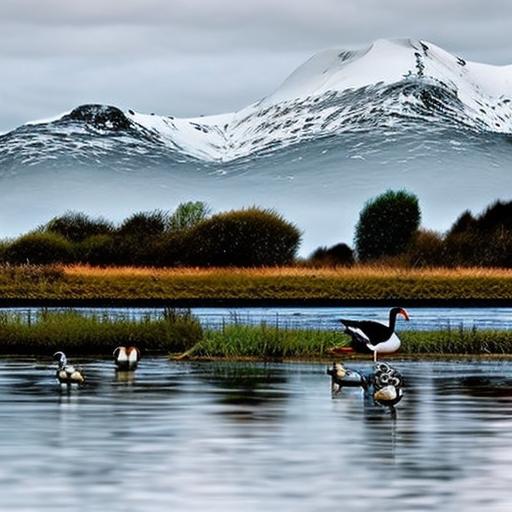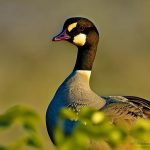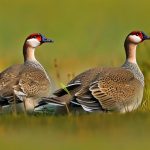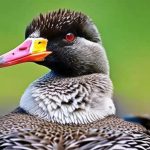Wild geese are a fascinating and majestic species of bird that can be found all over the world. These birds are known for their distinctive honking calls and their impressive V-shaped flight formations. Wild geese are highly social animals and are often seen in large flocks, especially during their annual migrations. They are also known for their strong family bonds and their ability to communicate with each other using a variety of vocalizations and body language. The world of wild geese is a complex and intriguing one, and there is much to learn about these remarkable birds.
Understanding the Different Breeds of Wild Geese
There are several different breeds of wild geese, each with its own unique characteristics and behaviors. Some of the most well-known breeds include the Canada goose, the snow goose, the greylag goose, and the barnacle goose. Each breed has its own distinct physical features, such as size, coloration, and markings, as well as specific habitats and migration patterns. Understanding the different breeds of wild geese is important for conservation efforts and for birdwatchers who want to spot and identify these birds in the wild.
The Characteristics and Behaviors of Wild Geese
Wild geese are known for their striking physical features, including long necks, webbed feet, and powerful wings. They are also highly intelligent and social animals, often forming strong bonds with their family members and flock mates. Wild geese are also known for their impressive flying abilities, with some species being able to fly at speeds of up to 70 miles per hour. In addition to their flying skills, wild geese are also excellent swimmers and are often found in or near bodies of water, where they feed on aquatic plants and insects. Understanding the characteristics and behaviors of wild geese is essential for appreciating and conserving these remarkable birds.
The Migration Patterns of Wild Geese
One of the most fascinating aspects of wild geese is their annual migration patterns. These birds are known for their long-distance migrations, which can cover thousands of miles as they travel between their breeding and wintering grounds. During their migrations, wild geese form impressive V-shaped flight formations, which help them conserve energy and navigate more efficiently. The timing and routes of these migrations are influenced by a variety of factors, including weather patterns, food availability, and the location of breeding and wintering grounds. Studying the migration patterns of wild geese is important for understanding their ecology and for implementing conservation measures to protect their habitats along their migration routes.
The Role of Wild Geese in Ecosystems
Wild geese play a crucial role in ecosystems around the world. As herbivores, they help to control the growth of aquatic plants and algae in wetland habitats, which can benefit a wide range of other species. In addition, their droppings provide important nutrients for the soil and can help to fertilize and enrich the habitats where they feed. Wild geese also serve as prey for a variety of predators, including foxes, coyotes, and birds of prey, and their presence can help to support the overall biodiversity of their habitats. Understanding the role of wild geese in ecosystems is essential for conserving these birds and the habitats they depend on.
Conservation Efforts for Wild Geese
Conservation efforts for wild geese are crucial for protecting these birds and their habitats. Threats to wild geese include habitat loss and degradation, hunting, pollution, and climate change. To address these threats, conservation organizations and government agencies work to protect and restore wetland habitats, regulate hunting practices, and raise awareness about the importance of wild geese and their ecosystems. In addition, research and monitoring programs help to track the populations and movements of wild geese, which can inform conservation strategies and management decisions. By supporting conservation efforts for wild geese, we can help to ensure the survival of these remarkable birds for future generations.
How to Spot Different Breeds of Wild Geese
Spotting and identifying different breeds of wild geese can be a rewarding and enjoyable experience for birdwatchers and nature enthusiasts. Each breed has its own unique physical features, such as size, coloration, and markings, as well as specific habitats and behaviors. By learning to recognize these characteristics, birdwatchers can improve their chances of spotting and identifying wild geese in the wild. Field guides, birding apps, and online resources can also be valuable tools for learning about the different breeds of wild geese and for honing your birdwatching skills.
The Diverse Habitats of Wild Geese
Wild geese can be found in a wide variety of habitats, including wetlands, grasslands, agricultural fields, and coastal areas. These birds are highly adaptable and can thrive in both natural and human-altered landscapes. Wetlands are particularly important habitats for wild geese, as they provide food, shelter, and breeding grounds for these birds. Protecting and restoring wetland habitats is essential for supporting healthy populations of wild geese and for maintaining the overall biodiversity of these ecosystems. By understanding the diverse habitats of wild geese, we can work to conserve and protect the places where these birds live and thrive.
The Cultural Significance of Wild Geese
Wild geese have long held cultural significance for people around the world. In many cultures, these birds are revered for their beauty, grace, and strength, and are often featured in art, literature, and folklore. In some traditions, wild geese are seen as symbols of loyalty, perseverance, and freedom, and are associated with stories and legends that have been passed down through generations. Understanding the cultural significance of wild geese can help to foster a deeper appreciation for these birds and the natural world as a whole.
Enjoying and Appreciating Wild Geese in the Wild
There are many ways to enjoy and appreciate wild geese in the wild. Birdwatching, photography, and nature walks are popular activities that allow people to observe and learn about these remarkable birds in their natural habitats. Many wildlife refuges and nature reserves also offer opportunities for guided tours and educational programs focused on wild geese and other bird species. By taking the time to connect with nature and observe wild geese in the wild, we can gain a greater understanding and appreciation for these birds and the ecosystems they depend on. Whether it’s watching a flock of geese in flight, listening to their honking calls, or witnessing their graceful movements on the water, there are countless ways to enjoy and appreciate the beauty and wonder of wild geese.
Meet Walter, the feathered-friend fanatic of Florida! Nestled in the sunshine state, Walter struts through life with his feathered companions, clucking his way to happiness. With a coop that’s fancier than a five-star hotel, he’s the Don Juan of the chicken world. When he’s not teaching his hens to do the cha-cha, you’ll find him in a heated debate with his prized rooster, Sir Clucks-a-Lot. Walter’s poultry passion is no yolk; he’s the sunny-side-up guy you never knew you needed in your flock of friends!







